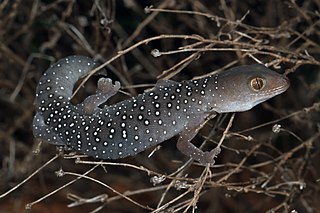
Strophurus is a genus of lizards in the family Diplodactylidae. All species of Strophurus are endemic to Australia, and are sometimes given the common names phasmid geckos, spiny-tailed geckos, and striped geckos.

The south-western spiny-tailed gecko, also known commonly as the soft spiny-tailed gecko, is a species of lizard in the family Diplodactylidae. The species is endemic to Australia. Two subspecies are recognized.

Diplodactylus vittatus, commonly known as the eastern stone gecko, stone gecko, and wood gecko, is a species of diplodactylid lizards that occurs in forest, shrubland and arid regions across Australia. It is widespread across the states of Queensland, Victoria and New South Wales, commonly found in dry peripheral bushlands. This gecko can be kept as a pet or seen within zoo enclosures.

The northern spiny-tailed gecko is a species of lizard in the family Diplodactylidae. The species is endemic to Australia.
Lucasium byrnei, also known commonly as the gibber gecko, Byrne's gecko, and the pink-blotched gecko, is a species of small, nocturnal lizard in the family Diplodactylidae. The species is endemic to Australia.
Diplodactylus calcicolus, sometimes called the south coast gecko, is a gecko endemic to Australia.

The variable fat-tailed gecko or burrow-plug gecko is a diplodactylid gecko endemic to central and arid inland areas of Australia. Widespread across the continent, the variable fat-tailed is most commonly found in sandy desert habitats dominated by Spinifex grasses. They have also been bred in captivity by zoos and as pets.
The Goldfields spiny-tailed gecko is a species of lizard in the family Diplodactylidae. The species is endemic to Australia.

Strophurus elderi, also known as the jewelled gecko, is a species of gecko, a lizard in the family Diplodactylidae. The species is endemic to Australia.
Strophurus jeanae, also known commonly as the southern phasmid gecko and Jean's spiny-tailed gecko, is a species of gecko, a lizard in the family Gekkonidae. The species is endemic to Australia.

Strophurus krisalys is a species of gecko, a lizard in the family Diplodactylidae. The species is endemic to Australia.
The short-tailed striped gecko, also known commonly as McMillan's spiny-tailed gecko, is a species of lizard in the family Diplodactylidae. The species is endemic to Australia.
The robust striped gecko, also known commonly as Michaelsen's spiny-tailed gecko, is a species of lizard in the family Diplodactylidae. The species is endemic to Australia.

The Exmouth spiny-tailed gecko, also known commonly as Rankin's spiny-tailed gecko, is a species of lizard in the family Diplodactylidae. The species is endemic to Western Australia.
The western spiny-tailed gecko is a species of lizard in the family Diplodactylidae. The species is endemic to Australia.

Strophurus taenicauda, also known commonly as the golden spiny-tailed gecko or the golden-tailed gecko, is a species of lizard in the family Diplodactylidae. The species is endemic to eastern Australia. Three subspecies are recognized.

The Western Shield spiny-tailed gecko, also known commonly as Wellington's spiny-tailed gecko, is a species of lizard in the family Diplodactylidae. The species is endemic to Australia.

Strophurus williamsi, also known commonly as the eastern spiny-tailed gecko, the soft-spined gecko, and Williams' spiny-tailed gecko, is a species of lizard in the family Diplodactylidae. The species is endemic to semi-arid regions of eastern Australia including Queensland, New South Wales, Victoria and South Australia. it has become a popular species as a pet for its distinctive tail features. S.williamsi has been grouped within a clade of seven other species that are believed to have diverged from their ancestors around 16 million years ago S.williamsi can be distinguished from closer relatives by arboreality and diurnal (day-active) activity.
The Mount Augustus spiny-tailed gecko, also known commonly as the Mount Augustus striped gecko and Wilson's spiny-tailed gecko, is a species of lizard in the family Diplodactylidae. The species is endemic to Australia.
The Eastern Deserts Fat-tailed gecko, Diplodactylus ameyi, is a small terrestrial species of gecko endemic to Australia, and is a part of the Diplodactylus genus.











